CUDC-305 is a novel synthetic HSP90 inhibitor with unique pharmacologic properties for cancer therapy.CUDC-305 shows high affinity for HSP90α/β (IC50, ~100 nmol/L) and HSP90 complex derived from cancer cells (IC50, 48.8 nmol/L). It displays potent antiproliferative activity against a broad range of cancer cell lines (mean IC50, 220 nmol/L). CUDC-305 exhibits high oral bioavailability (96.0%) and selective retention in tumor (half-life,20.4 hours) compared with normal tissues. Furthermore, CUDC-305 can cross bloodbrain barrier and reach therapeutic levels in brain tissue. CUDC-305 exhibits dosedependent antitumor activity in an s.c. xenograft model of U87MG glioblastoma and significantly prolongs animal survival in U87MG orthotopic model. CUDC-305 also displays potent antitumor activity in animal models of erlotinib-resistant non–small cell lung cancer and induces tumor regression in animal models of MDA-MB-468 breast cancer and MV4-11 acute myelogenous leukemia. Correlating with its efficacy in these various tumor models, CUDC-305 robustly inhibits multiple signaling pathways, including PI3K/AKT and RAF/MEK/ERK, and induces apoptosis. In combination studies, CUDC-305 enhances the antitumor activity of standard-of-care agents in breast and colorectal tumor models.

Patent: US20230218577A1 2023 Jul.
Use of heat shock protein inhibitors for the treatment of neurodevelopmental disorders
CUDC-305 purchased from AbMole

Sci Rep. 2017 Feb 8;7(1):201..
Proteomic analysis of proteome and histone post-translational modifications in heat shock protein 90 inhibition-mediated bladder cancer therapeutics
CUDC-305 purchased from AbMole
| Cell Experiment | |
|---|---|
| Cell lines | BT474, N87, H1975, H1993, Calu-6 and H460 cells line |
| Preparation method | Cell growth and viability assay. Human cancer cell lines were purchased from American Type Culture Collection and plated at 5,000 to 10,000 per well in 96-well plates with culture medium, as suggested by the provider. The cells were then incubated with compounds at various concentrations for 120 h. Growth inhibition was assessed by ATP content assay using the Perkin-Elmer ATPlite kit. Briefly, a 25-μL cell lysis solution was added to the 50-μL phenol red–free culture medium per well to lyse cells and stabilize ATP. Then 25-μL substrate solutions were added to the wells, and subsequently, luminescence was measured with a TopCount liquid scintillation analyzer (Perkin-Elmer). Values were expressed as a percentage relative to those obtained in untreated controls. IC50 values were calculated using PRISM software (GraphPad Software) with sigmoidal dose-response curve fitting. |
| Concentrations | 0~900nM |
| Incubation time | 120h |
| Animal Experiment | |
|---|---|
| Animal models | U87MG glioblastoma tumor models |
| Formulation | formulated in 30% Captisol |
| Dosages | single 160 mg/kg |
| Administration | oral gavage |
| Molecular Weight | 442.58 |
| Formula | C22H30N6O2S |
| CAS Number | 1061318-81-7 |
| Solubility (25°C) | DMSO 10 mM |
| Storage |
Powder -20°C 3 years ; 4°C 2 years In solvent -80°C 6 months ; -20°C 1 month |
| Species | Mouse | Rat | Rabbit | Guinea pig | Hamster | Dog |
| Weight (kg) | 0.02 | 0.15 | 1.8 | 0.4 | 0.08 | 10 |
| Body Surface Area (m2) | 0.007 | 0.025 | 0.15 | 0.05 | 0.02 | 0.5 |
| Km factor | 3 | 6 | 12 | 8 | 5 | 20 |
| Animal A (mg/kg) = Animal B (mg/kg) multiplied by | Animal B Km |
| Animal A Km |
For example, to modify the dose of Compound A used for a mouse (20 mg/kg) to a dose based on the BSA for a rat, multiply 20 mg/kg by the Km factor for a mouse and then divide by the Km factor for a rat. This calculation results in a rat equivalent dose for Compound A of 10 mg/kg.
| Related HSP Products |
|---|
| Hsp70-derived octapeptide
Hsp70-derived octapeptide is a conserved octapeptide of the C-terminal end of Hsp70, which physically interacts with tetratricopeptide repeat (TPR) motifs. |
| p5 Ligand for Dnak and DnaJ
p5 Ligand for Dnak and DnaJ is a nonapeptide, which corresponds to the main binding site for the 23-residue part of the presequence of mitochondrial aspartate aminotransferase. |
| Tertomotide hydrochloride
Tertomotide hydrochloride is a peptide consisting of 16 amino acids containing sequences derived from human telomerase reverse transcriptase (TERT).Tertomotide penetrates cells and interacts with HSP70 and HSP90, as well as inhibiting amyloid beta and tau, and inhibiting aging-related signaling in the brain. pathways, which could be used in aging and Alzheimer's disease related studies. |
| BMS-986263
BMS-986263 is a small interfering RNA (siRNA) that targets Hsp47 and can be used in studies related to idiopathic pulmonary fibrosis (IPF). |
| AT-533
AT-533 is a potent Hsp90 and HSV inhibitor. |


Products are for research use only. Not for human use. We do not sell to patients.
© Copyright 2010-2023 AbMole BioScience. All Rights Reserved.
